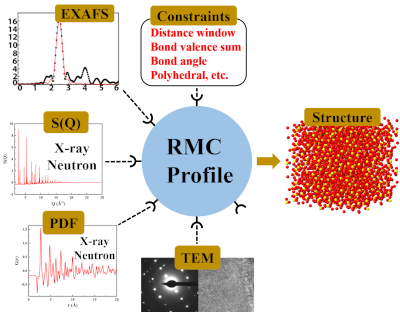
RMCProfile
Reverse Monte Carlo for crystalline and disordered materials
Follow the announcements regarding the RMCProfile website here.
Follow the release notes of ORNL powder diffraction software here.
Follow the roadmap of ORNL powder diffraction software here.
If GSAS-II is used to generate the Bragg profiles, please use GSAS3_NEW as the BRAGG_SHAPE option in RMCProfile setup. Refer to the manual for more options.
Citation — If RMCProfile was used in your research, please consider cite the following papers,
[1] Matthew G Tucker, et al. 2007, J. Phys.: Condens. Matter, 19, 335218.
[2] Yuanpeng Zhang, et al. 2020, J. Appl. Cryst., 53, 1509-1518.
Welcome to the RMCProfile website hosted at Oak Ridge National Laboratory (ORNL) in US. Here you can download the RMCProfile software, view documentation and examples, join community for discussion and learn about updates of the package, etc.

This version of RMC was built from the original RMCA code of McGreevy & Pusztai to determine the local structure of crystalline materials while still being capable of analyzing disordered systems. The current version of RMCProfile results from a collaboration between scientists at ISIS facility (UK), Spallation Neutron Source (SNS at Oak Ridge National Laboratory, US), University of Cambridge (UK), University of Oxford (UK), Queen Mary University of London (QMUL, UK) and National Institute of Standards and Technology (NIST, US). It is now possible to fit many data types simultaneously (Neutron & X-ray total scattering & the Bragg profile, EXAFS, single crystal diffuse scattering) and use a range of constraints to produce atomic models that are consistent with all the available data. In this way we are progressing the effort to develop a ‘complex modeling’ approach to elucidate structural details of materials that are the key to their exploitable functional properties.
If any issues with the RMCProfile package, any questions or any ideas to try out concerning the application of RMC method for modeling comprehensive data, please feel free to join the community discussion. Discussions are hosted as GitHub issues and one can view them without a GitHub account. To join the discussion, one does need a GitHub account, to either submit new issues or comment on other issues.


